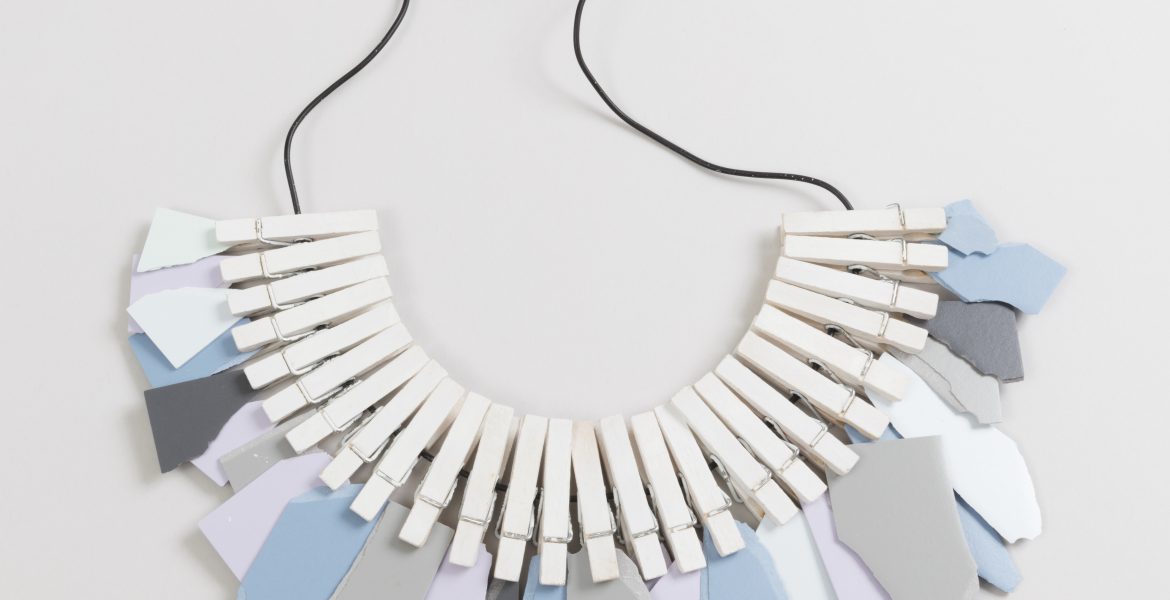
The ringleaders of contemporary art jewelry: The Susan Grant Lewin Collection at the Cooper Hewitt
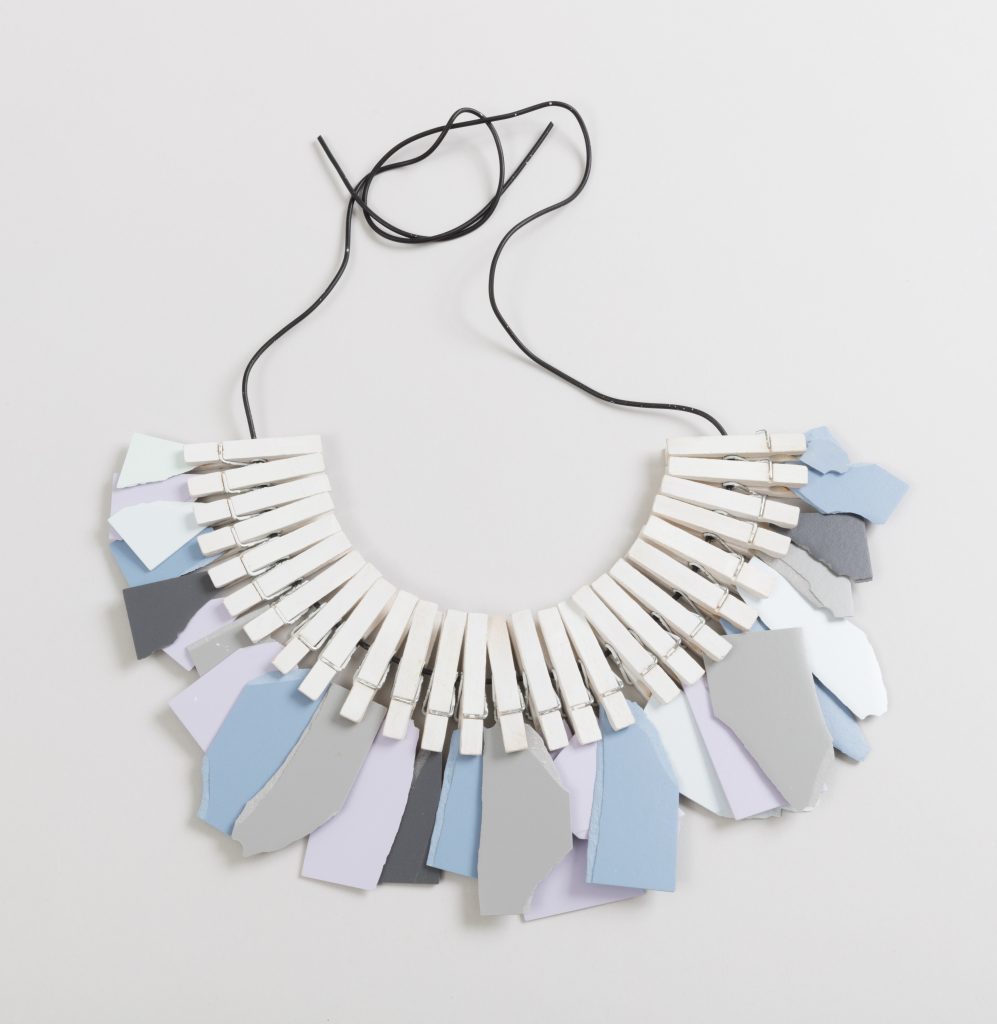
Ivy Ross; Necklace from the Colorcore Personal Adornment Series, 1983; Colorcore Formica fragments, clothespins (painted wood, metal), cord; L x W x D: 36.3 x 26.4 x 1.3 cm (14 5/16 x 10 3/8 x 1/2 in.); The Susan Grant Lewin Collection, Cooper Hewitt, Smithsonian Design Museum; Photo: Matt Flynn © Smithsonian Institution
Cooper Hewitt, Smithsonian Design Museum has recently been able to fill a void in their holdings thanks to Susan Grant Lewin and her collection of contemporary art jewelry. The exhibition Jewelry of Ideas: Gifts from the Susan Grant Lewin Collection, on view through May 28, 2018, spotlights the 150 pieces, only a small tip of the iceberg, that Grant Lewin has decided to part with. Grant Lewin, the former creative director at the Formica Corporation and now head of her own public relations agency, has long been a respected force in the contemporary art jewelry world. The collecting bug bit her more than two decades ago on a business trip to Copenhagen. A visit to the studio of artist Vivianna Torun Bülow- Hübe ignited within her a passion for the subject that has remained to this day.
Grant Lewin will be the first to tell you that what she looks for in the work of the artists whom she collects is innovation and experimentation, be it in materials or techniques. In fact, Sarah D. Coffin, senior curator of product design and decorative arts, says that “the use of an innovative process and/or materials are key elements of Cooper Hewitt’s overall criteria for all collection objects.” The exhibition is an impressive range of work: on display is a seminal bangle bracelet by Bülow- Hübe, along with work by emerging artists such as Aric Verrastro and more established ones like Jamie Bennett and Kiff Slemmons. “Susan rejects pre-conceived notions with regard to materials and techniques or size while caring deeply about the artist’s concepts and execution,” observes Ursula Ilse-Neuman, the jewelry curator who organized this exhibition with the Cooper Hewitt. “Starting from a very personal reaction to wanting to wear a piece, Susan’s proven gift is to acquire works that establish a meaningful discourse with a far broader audience.”
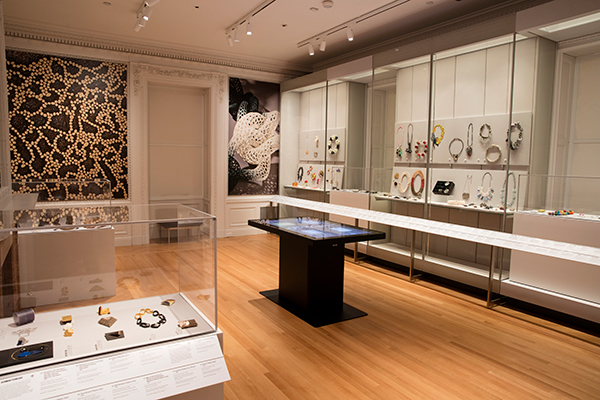
Gallery views. Matt Flynn © Smithsonian Institution.
She approached her collection as a historian and journalist would, having started her career as the latter. In 1994, at the prodding of renowned American jeweler Robert Ebendorf, she published One of A Kind: American Art Jewelry Today. Grant Lewin traveled the country, visiting jewelers in the studio and shared their achievements in her book. About fifteen years ago, she shifted her focus to the European market when she, along with Ilse-Neuman and artist Thomas Gentille, went to Munich for Schmuck, the world renowned contemporary jewelry exhibition, which has been taking place annually since 1959.
Grant Lewin wears all of the jewelry in her collection, and it was important that, while the pieces may be displayed as objects, they all function as jewelry. She has a predilection for necklaces, and like most art collectors, knows a piece is for her because of that “strong feeling” that she gets. However since she always planned on donating her collection to a museum, she “recognized the need for seminal pieces by seminal artists” in her collection and carefully filled those gaps acquiring work by Manfred Bischoff and Bruno Martinazzi, for example. In addition she collected pieces by her favorite artists, including Gentille, Kiff Slemmons, Petra Zimmermann, Iris Eichenberg, and Eva Eisler, to name a few, in depth.
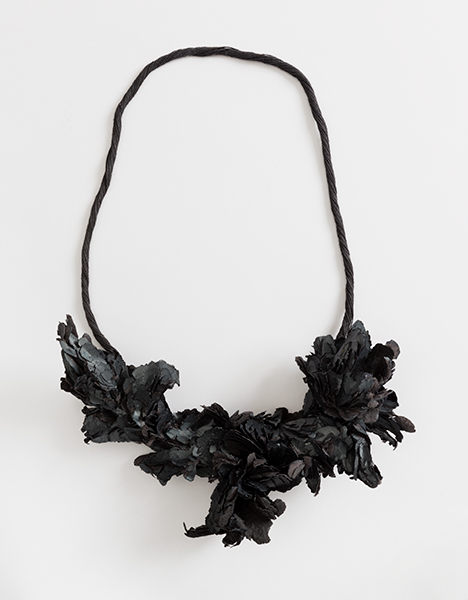
Untitled (5) from the Compounding Fractions Series by Attai Chen, 2010. Paper, paint, coal, glue, and linen. The Susan Grant Lewin Collection, Cooper Hewitt, Smithsonian Design Museum; Matt Flynn Photo © Smithsonian Institution.
Grant Lewin says that she is still in disbelief that “one day these pieces were sitting in her jewelry box and now they are in the museum being handled with white gloves.” The museum’s curators, who first saw her 500-plus piece collection sprawled out in front of them in her apartment, must also be pleased that the museum is now their home. “Since the Hewitt Sisters founded the Cooper Union museum’s collection at the end of the nineteenth century, jewelry in a variety of materials has been a part of the holdings, but with an emphasis on historical works,” explains Cynthia Trope, associate curator of product design and decorative arts. “The Susan Grant Lewin Collection gift most importantly enables us to present a much more comprehensive and up to the minute picture of how jewelry as a design discipline has developed in recent years. The group also prompts us to explore how our views on the meanings and significance of jewelry in the modern world have been, and are still, changing.”
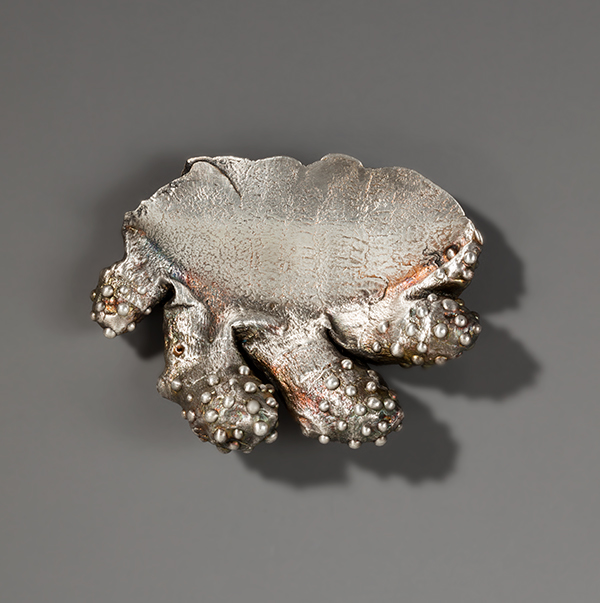
Ginger Brooch in electroformed silver from the Ginger Series by Sam Tho Duong, 2004. The Susan Grant Lewin Collection, Cooper Hewitt, Smithsonian Design Museum; Matt Flynn Photo © Smithsonian Institution.
The intimate setting of the museum’s Second floor gallery allows the viewer a closer look at the materials, processes, and different schools of thought that make contemporary jewelry one of the most exciting areas for exploration. A panoply of colors and forms greets visitors and invites them to consider how our bodies can be repositories for jewelry that is much more than simply about adornment yet still beautiful and bold. And as demonstrated by Grant Lewin herself, these pieces can and should be worn everyday. Neuman organized the exhibition thematically, and the layout also corresponds to the illuminating essay that she wrote for the exhibition catalogue.
Grant Lewin’s ultimate goal was “to preserve the work and make it available for future generations.” Not only does this exhibition celebrate the field and educate the museum’s audience but it will also get young collectors excited. “Contemporary jewelry is undervalued and if someone is debating between contemporary art and contemporary jewelry, then there is no comparison,” adds Grant Lewin. Surely anyone who visits this exhibition will see her point.
Bella Neyman is an independent contemporary jewelry curator and writer based in Brooklyn, NY.
1 comment
Leave a Reply Cancel reply
Calendar
| M | T | W | T | F | S | S |
|---|---|---|---|---|---|---|
| 1 | 2 | 3 | 4 | 5 | 6 | 7 |
| 8 | 9 | 10 | 11 | 12 | 13 | 14 |
| 15 | 16 | 17 | 18 | 19 | 20 | 21 |
| 22 | 23 | 24 | 25 | 26 | 27 | 28 |
| 29 | 30 | 31 | ||||
Archives
- June 2018
- March 2018
- December 2016
- January 2016
- November 2015
- September 2015
- August 2015
- June 2015
- March 2015
- February 2015
- December 2014
- November 2014
- October 2014
- May 2014
- April 2014
- January 2014
- December 2013
- November 2013
- October 2013
- September 2013
- June 2013
- May 2013
- April 2013
- March 2013
- February 2013
- December 2012
- November 2012
- October 2012
- September 2012
- August 2012
- July 2012
- June 2012
- May 2012
- April 2012
- March 2012
- February 2012
- January 2012
- December 2011
- November 2011
- October 2011
- September 2011
- July 2011
- June 2011
- May 2011
- April 2011
- March 2011
- February 2011
- January 2011
- December 2010
- November 2010
- October 2010
- September 2010
- July 2010
- June 2010
- May 2010
- April 2010
- March 2010
- February 2010
- January 2010
- December 2009
- November 2009
- October 2009
- September 2009
- August 2009
- July 2009
- June 2009
Categories
- 20th c. design
- Architecture
- Art Deco
- Art Jewelry Forum
- Art Nouveau
- Auction
- Bard Graduate Center
- Blog update
- Brooklyn Metal Works
- Brooklyn Museum
- Ceramics
- Christie's
- Contemporary Art
- Contemporary Design
- Cooper-Hewitt
- Costume Institute
- Decorative Arts Calendar
- Design Exhibition Review
- Designer Spotlight
- Exhibition review
- Extraordinary lives
- Fashion
- Fashion exhibition review
- Fashion photography
- Film
- Fresh Talent
- Furniture
- Gallery Spotlight
- Glass
- ICP NY
- Italian Design
- Jewelry
- Lecture
- MCNY
- Metropolitan Museum of Art
- MoMA
- Museum at F.I.T
- Museum of Arts and Design
- Neue Galerie NY
- On the Market
- Paper Art
- Paris
- Phillips de Pury & Company
- Pinakothek de Moderne
- Platforma
- Public Art
- Rago
- Recently Published Articles
- Russian Decorative Arts
- R|R Gallery
- Sculpture
- Sotheby's
- Television
- Textiles
- Travel
- Uncategorized
- Upcoming Events
- Vintage Clothing
- Wiener Werkstatte
- Wright
Welcome back, Bella, we missed you.